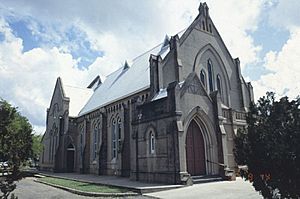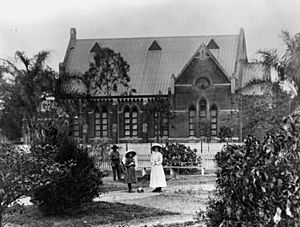St Andrew's Presbyterian Church, Rockhampton facts for kids
Quick facts for kids St Andrew's Presbyterian Church, Rockhampton |
|
|---|---|

St Andrew's Presbyterian Church, 1993
|
|
| Location | 280 Bolsover Street, Rockhampton, Rockhampton Region, Queensland, Australia |
| Design period | 1840s - 1860s (mid-19th century) |
| Built | 1893 - 1926 |
| Architect | Voller & Graham |
| Architectural style(s) | Gothic |
| Official name: St Andrew's Presbyterian Church | |
| Type | state heritage (built) |
| Designated | 21 October 1992 |
| Reference no. | 600785 |
| Significant period | 1880s-1890s (historical) 1890s-1920s (fabric) |
| Significant components | stained glass window/s, church, pipe organ, memorial/monument, furniture/fittings |
| Lua error in Module:Location_map at line 420: attempt to index field 'wikibase' (a nil value). | |
St Andrew's Presbyterian Church is a historic church building located at 280 Bolsover Street in Rockhampton, Queensland, Australia. It was designed by the architects Voller & Graham and built between 1893 and 1926. This beautiful church is listed on the Queensland Heritage Register, which means it's an important part of Queensland's history and culture.
Contents
A Look Back in Time
How the Church Began
St Andrew's Presbyterian Church was built in 1893-1894 for the Presbyterian Church community in Rockhampton. This group, called the Presbytery of Rockhampton, was formed in 1865. Architects were asked to submit designs, and the plan by Brisbane architects Voller & Graham was chosen. A local architect, John William Wilson, oversaw the building work, and Walter Adam Lawson was the builder.
A large donation of £1000 from William Pattison, a wealthy businessman from the Mount Morgan gold mine, helped fund the church. This church shows how rich Rockhampton was during the gold mining boom.
Early Days of Worship
Presbyterian worship started in Rockhampton soon after many people moved there because of the Canoona gold rush in 1858. William John Brown, a customs officer and a member of the Presbyterian Church, led the first services. People met in different places like a store, a timber yard, and the local courthouse.
In 1861, Reverend Samuel Kelly was invited to Rockhampton to become the first Presbyterian Minister. A committee was formed, and they received land from the government. A timber church was built on this land, which is the same spot where the current church stands. By 1864, a house for the minister, called a manse, was built nearby as the church community grew quickly.
Growing Bigger
In 1876, Reverend Alexander Hay became the minister. As the church community continued to grow, a second manse was built in 1878. In 1882, the original timber church was made larger by adding a transept (a part of the church that sticks out, making it look like a cross).
Even though a separate Presbyterian group started in Rockhampton in 1888, the original St Andrew's congregation kept growing strong.
A Special Gift and New Beginnings
On October 2, 1890, Reverend Hay announced that William Pattison, a shareholder in the Mount Morgan Gold Mine and a member of the Queensland Parliament (MLA), promised £1000 to build a new church. In 1894, the church also got a loan of £800 from the Bank of New South Wales.
The first stone of the new church was laid on June 7, 1893, by Mrs. Peter McIntosh. Her father, William J Brown, was the person who started Presbyterianism in Rockhampton. A bottle containing a brief history of Rockhampton and other papers was placed under this stone. The new church officially opened on April 15, 1894.
The church was first built with special bricks and stone. The original plan included a tall tower facing Bolsover Street, but it was too expensive and was not built. If it had been built, St Andrew's would have looked very similar to the St Pauls Presbyterian Church in Mackay, which was also designed by Walter Carey Voller.
The inside walls were painted a dark grey, and the window frames were white. The church pews (benches) were made of Queensland Pine wood. The church was lit by gas lights. The inside was completed in 1900 when a large pipe organ was installed. This organ was built by a Sydney company. In 1897, a bell was given to the church. This bell, made in London, celebrates Queen Victoria's 60 years as queen (her Diamond Jubilee). It is still visible at the church's south-west corner.
Changes Over the Years
By 1925, the church needed repairs because its foundations were moving. In 1926, new communion furniture was added. In 1939, the church decided to cover the outside with a smooth layer of plaster, called render, and raised money for it in 1940. In 1947, parts of the church's inside, like the pulpit (where the minister speaks) and choir seats, were rearranged. A choir room was also built.
Between 1947 and 1971, beautiful stained glass windows were put in. In 1981, a study of the building's structure was done, leading to major repair work in 1984. The church was closed for several months. During this time, a concrete path was laid around the building, a new roof and floor were installed, and the outside was repainted.
A separate concrete building, St Andrew's Hall, was built next to the church and opened in 1936. This hall was for the Sunday School. The old manse (minister's house) was sold and moved to make space for the new hall.
What the Church Looks Like
Outside the Church
St Andrew's Church is a building made of stone or brick covered with render (a smooth plaster finish). It has a ribbed metal roof that slopes down on two sides, like a house roof, with small vents at the top. The building has buttresses (strong supports on the outside walls) and decorative lines called string courses. The render is made to look like large, cut stones.
The main entrance faces Bolsover Street. It has a single-story front section called a narthex, with two smaller entrance areas on each side. Each entrance has a pointed arch with a decorative frame and double wooden doors. The top part of these entrances has stone patterns.
The sides of the church have four sections, each with two tall, narrow windows called lancet windows. These windows have decorative frames. There are also shallow transepts (parts that stick out from the sides).
The back of the church has a projecting chancel (the area around the altar) and a smaller room called a vestry on the side. A concrete path goes around the building. The special bell, which celebrates Queen Victoria's Diamond Jubilee, is located near the vestry.
Inside the Church
Inside, the church has rendered walls and a high, sloped timber ceiling. A large pointed arch leads into the chancel, which holds a big, fancy pipe organ. In front of the organ is a raised pulpit. Many of the lancet windows have beautiful stained glass or leadlight panels.
The entrance areas and the narthex have floors made of encaustic tiles (decorative tiles). Three pointed arches separate the narthex from the main part of the church, called the nave. These arches have wooden screens, and the side arches have doors. A small "crying room" has been built in the middle of the narthex, with a window to see into the church. The church also has several plaques that remember important events, including those from World War I and World War II.
Next to the church, facing Bolsover Street, is St Andrew's Hall. There's also a car park at the back and some large plants between the two buildings.
Why This Church is Special
St Andrew's Presbyterian Church was added to the Queensland Heritage Register in 1992 because it meets several important criteria.
A Piece of History
This church was built in 1894 when Rockhampton was very rich because of the gold mining at Mount Morgan. The church was funded by William Pattison, a wealthy person from the Mount Morgan Gold Mining Company. It shows the fancy buildings that were built in Rockhampton when it was a very important business center in central Queensland. At that time, some people even wanted Rockhampton to be the capital of a new northern state. The church also shows how the Presbyterian Church grew in Queensland. St Andrew's was the first Presbyterian church to be established so far north in Queensland, and the building shows how important the Presbyterian community was in the early days of Rockhampton.
Beautiful Design
St Andrew's Presbyterian Church is considered beautiful because of its design, materials, and how it was built. It adds a lot to the look of Rockhampton's streets and the city itself. The inside of the building also has lovely materials and finishes, showing high-quality work.
Important to the Community
The church is very important to the people who worship there, as it has been their place of worship for over 100 years. It is also important to all the people of Rockhampton because it is a well-known building that helps define the city's image.


